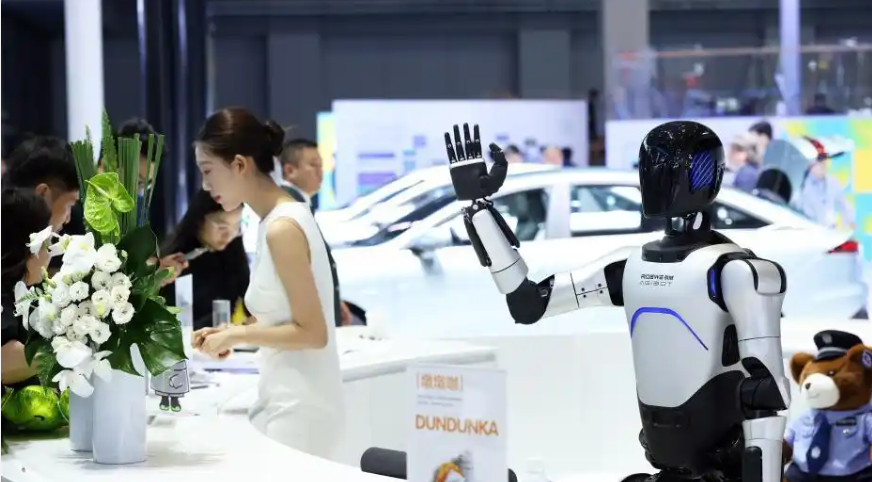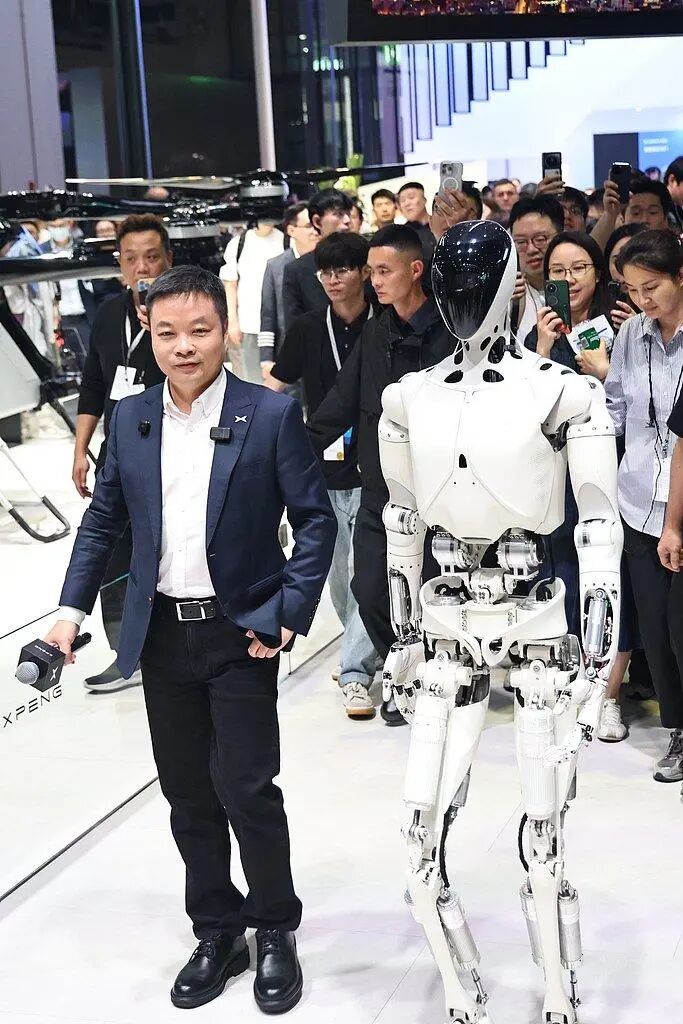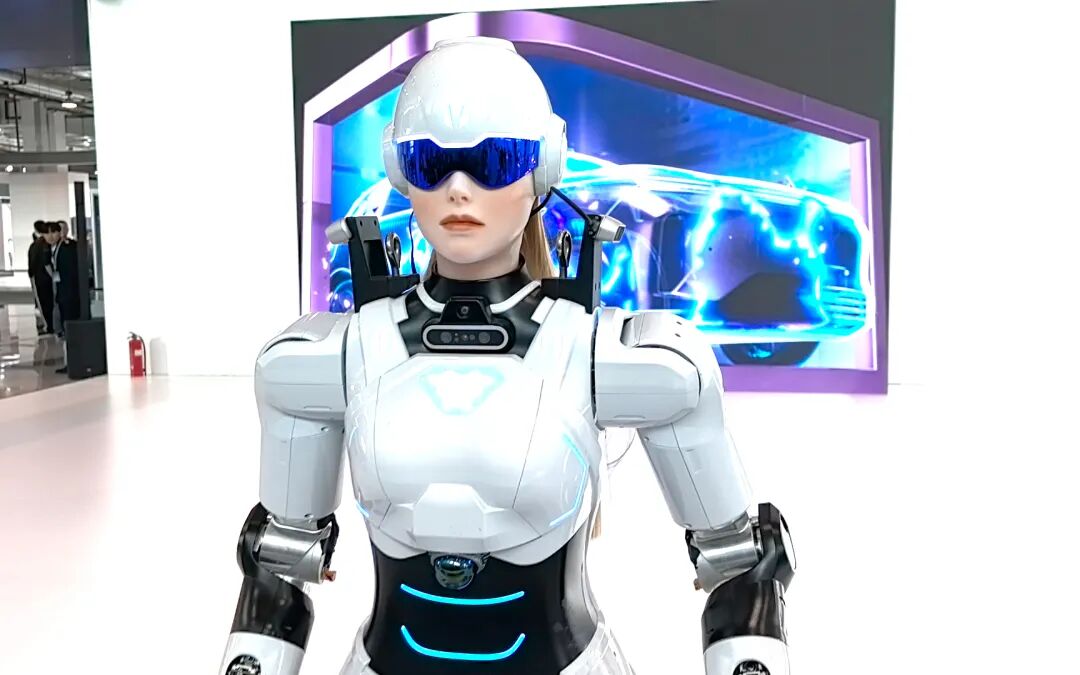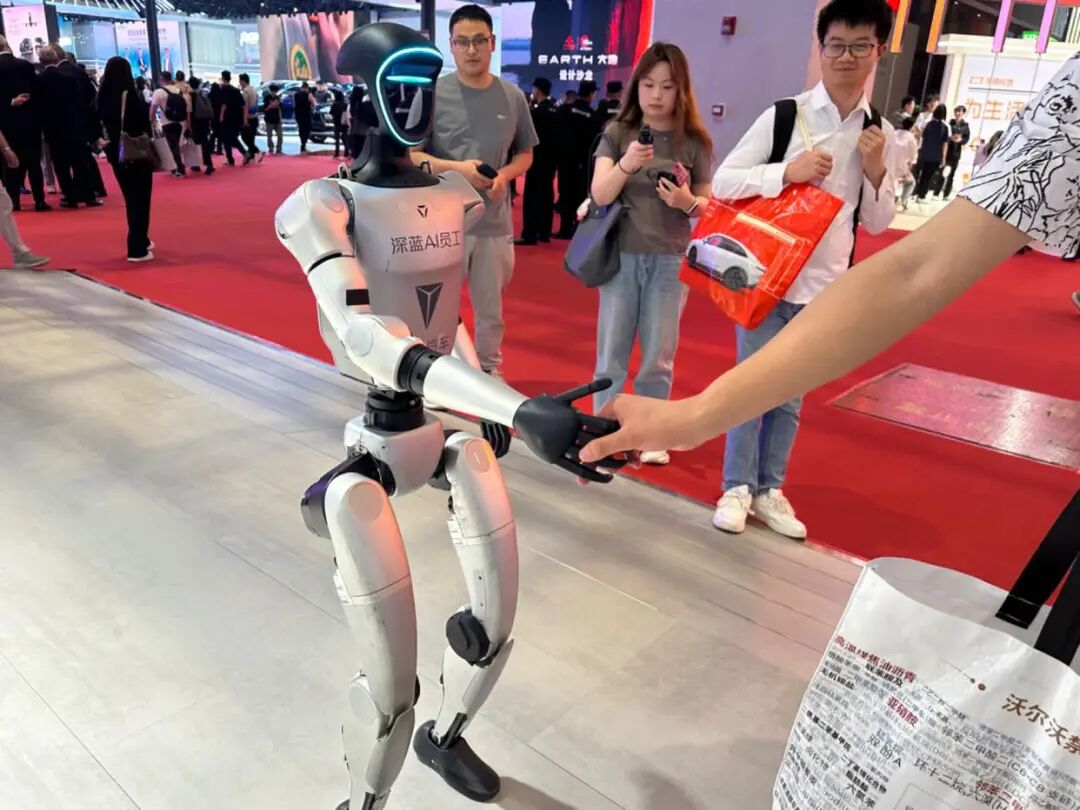Auto Show Spectacle, Technology Unveiled
The 2025 Shanghai Auto Show feels like a grand celebration where automobiles and technology intertwine. Crowds throng inside and outside the exhibition halls, with an air of excitement and anticipation. The booths of major automotive brands compete for attention, showcasing the latest allure of the automotive industry with dazzling lights and innovative designs.
Amidst this splendor, humanoid robots emerge as a shining star, undoubtedly becoming the focal point of the auto show. They stand elegantly beside the display cars, acting as diligent companions, or nimbly weave through the crowd, attracting countless gazes. Whether they are professional automotive practitioners or curious onlookers, everyone is captivated by these futuristic robots, stopping to marvel at the wonders of technology.
“Intelligent Dancer”: Agile Mechanical Bodies
Among the many humanoid robots, the Xiaopeng Robot IRON is undoubtedly a dazzling star. Standing at 178 cm tall and weighing 70 kg, it exudes a unique charm of future technology. With its pristine white “skin” and smooth lines, its overall appearance resembles a mechanical warrior straight out of a sci-fi movie, with every detail showcasing the perfect blend of technology and aesthetics.
When it began its demonstration at the auto show, the atmosphere was instantly ignited. It first stepped forward gracefully, its stable and fluid walking posture resembling a trained model on a runway. Then, it greeted people with a friendly fist bump, its movements precise and powerful, as if conveying a friendly greeting from the future. In response to the enthusiastic calls from the audience, it raised its arm and waved casually, its agile fingers bending slightly as if greeting an old friend. Subsequently, it playfully made a “Yay” gesture, bringing smiles to the audience with its adorable demeanor, as camera shutters clicked in rapid succession.
The ability of IRON to perform these actions is attributed to its 62 active degrees of freedom throughout its body, with 22 degrees of freedom in its hands. This allows its joints to be as flexible as those of a human, enabling it to easily execute various complex movements, showcasing a highly anthropomorphic capability that leaves one in awe of technological marvels.
“Thoughtful Sales Assistant”: An Automotive Expert Ready to Answer
At the Chery booth, there is a special “employee” — the humanoid robot Mornine, which also performed impressively. It acts like a professional and considerate automotive sales assistant, well-versed in various automotive knowledge, providing meticulous service to the audience.
When Zhou Hongyi, founder of 360 Group, visited the Chery booth, he curiously asked Mornine, “What is the biggest advantage of Chery cars?” Mornine responded swiftly, answering clearly and fluently, “The biggest advantage of Chery cars is their innovative design and reliable quality. I can provide model consultations; feel free to ask me any questions.” This fluent exchange garnered nods of approval from the surrounding audience. It can accurately answer common questions about car performance, configuration, and pricing, and can also provide personalized car-buying advice based on the audience’s needs, much like an experienced sales consultant.
Even more surprising, Mornine possesses practical operational capabilities. When an audience member requested a drink, it walked steadily to a nearby cabinet, extended its agile arm, precisely picked up the drink, and elegantly handed it to the audience member, executing the action seamlessly without any hiccups. The naturalness and fluidity of this human-robot interaction evoke admiration for the advancements in technology that have allowed robots to integrate so closely into our lives.
“Future Employees”: The New Darlings of Automotive Companies

Beyond showcasing their talents at the auto show, humanoid robots are also expected to play significant roles on automotive production lines, becoming the “future employees” of automotive companies. More and more automotive manufacturers are beginning to recognize the immense potential of humanoid robots and are accelerating their investments in this field.
From a technical perspective, there are intricate connections between intelligent vehicles and humanoid robots, with many aspects sharing technological origins. For instance, the environmental perception technology for autonomous driving in intelligent vehicles acts like giving cars a keen “eye” to recognize various situations on the road; similarly, humanoid robots require such “eyes” to perceive their surroundings, enabling autonomous navigation and interaction with humans. Likewise, human-robot interaction and motion control technologies play crucial roles in both intelligent vehicles and humanoid robots, allowing cars to maneuver flexibly based on driver commands and enabling humanoid robots to perform various actions like humans.
In terms of hardware, the main architecture of cars and the “bodies” of robots often share the same products, such as motors, batteries, sensors, and reducers, which are core components that have matured in the automotive supply chain and can now be effectively utilized in humanoid robots. On the software side, the two are highly “interconnected,” as automotive driver assistance technologies can be adapted for robots; for example, visual recognition algorithms and environmental perception technologies used in driver assistance can be directly applied to robot navigation and interaction.
From a supply chain perspective, there is a significant overlap between the supply chains of humanoid robots and automotive manufacturing. This means that automotive companies can fully leverage existing supply chain resources when producing humanoid robots, quickly obtaining the various components needed for robot manufacturing, thereby reducing procurement costs and production cycles. As a result, automotive companies can produce humanoid robots at lower costs and higher efficiency, allowing these “future employees” to enter factories more rapidly.
In the future automotive production lines, humanoid robots will undertake a variety of tasks. They can effortlessly handle loading and unloading tasks, acting like tireless movers, accurately transporting components to designated locations; during welding processes, they ensure that every weld point is secure and reliable with their precise operations; in adhesive application tasks, they can evenly spread glue, ensuring product quality. Moreover, humanoid robots can work in hazardous and harsh environments, such as areas with high temperatures, high pressure, and high radiation, ensuring worker safety.
As humanoid robots become widely used on automotive production lines, the automotive production model will undergo significant transformation. Production efficiency will greatly increase, with tasks that previously required substantial manpower and time now being completed quickly and accurately by robots. The flexibility and adaptability of production will also enhance, as robots can rapidly adjust their tasks and processes based on different production needs. This will enable automotive companies to better respond to market changes and produce products that more closely meet consumer demands.
Humans and Robots Together, Driving Towards the Future
The stunning performance of humanoid robots at the 2025 Shanghai Auto Show has shown us the infinite possibilities of intelligent development in the automotive industry. They are no longer distant sci-fi fantasies but have genuinely entered our lives, closely intertwined with the automotive industry.
In the future, as technology continues to advance, the application of humanoid robots in the automotive field will become even more widespread and profound. They may become our good companions in daily travel, sitting with us in cars and providing various thoughtful services; on automotive production lines, they will become efficient “workers,” significantly enhancing production efficiency and product quality; in showrooms, they will serve as professional “sales assistants,” offering customers a premium car-buying experience. The integration of automobiles and humanoid robots will bring us a more intelligent, convenient, and safe way of travel, ushering in a new era of intelligent mobility.


